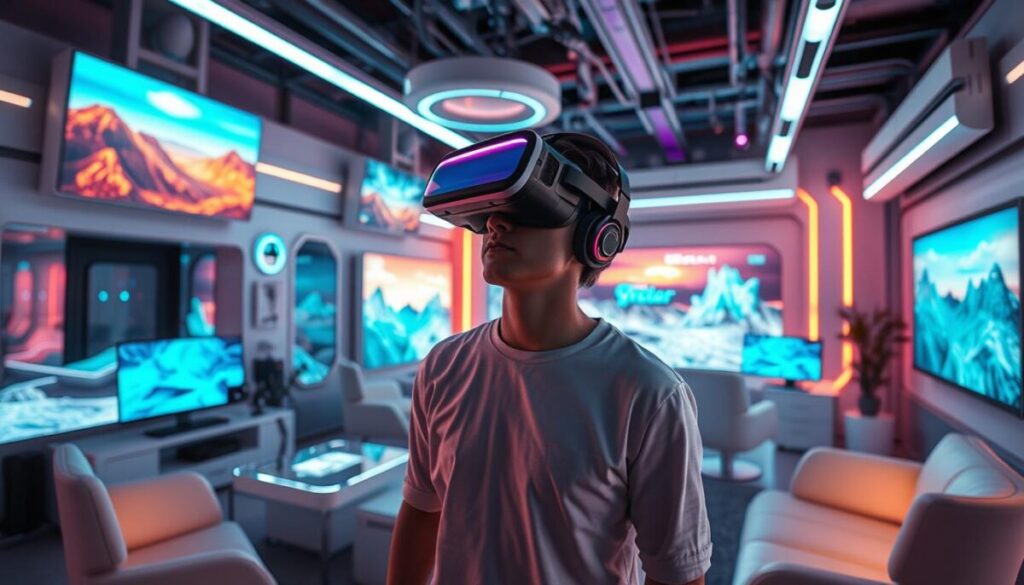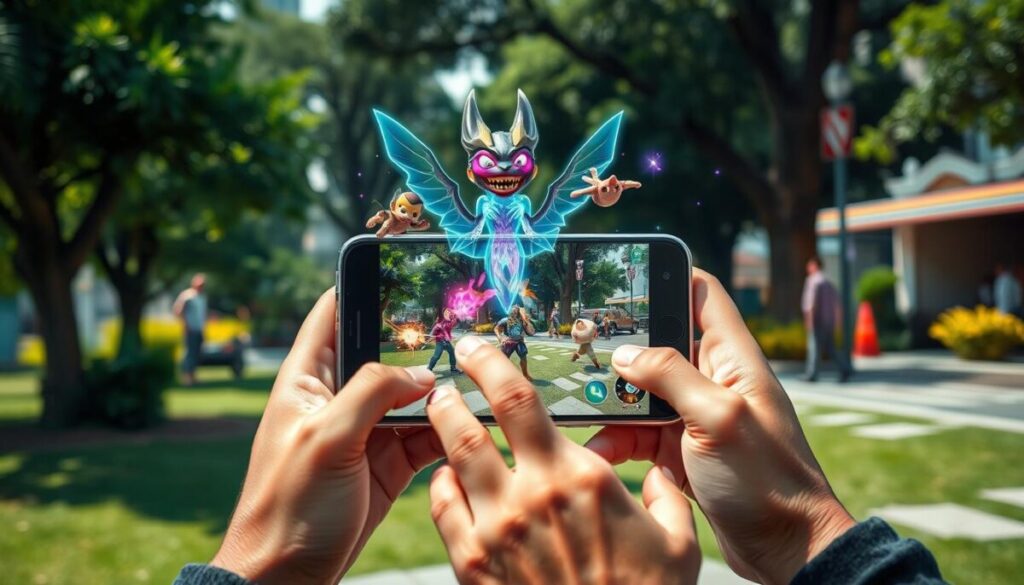Augmented reality (AR) has transformed mobile gaming, enabling players to interact with their surroundings in unprecedented ways. As I delve into AR technology, it’s evident that it boosts immersive experiences. It blends the digital and physical realms seamlessly. Games like Pokémon Go showcase AR’s immense potential in mobile gaming, drawing many developers into this new frontier.
Unity Technologies is a key player in AR game development, offering tools for creating complex games across various platforms. The Unity AR Foundation framework makes integrating AR features easier, broadening mobile gaming’s reach. This ease, combined with Unity’s Asset Store, speeds up development and fosters creativity among developers.
The future of AR in mobile gaming is bright, with technology continually evolving. The Xreal Air 2 Ultra AR glasses, for instance, bring spatial computing to the market. Meanwhile, innovative games like Table Trenches and Landing Party are redefining how we experience digital overlays on real-world environments. These advancements not only engage users but also open up new avenues for businesses to interact with consumers and boost foot traffic.
What is Augmented Reality in Gaming?
Augmented reality gaming revolutionizes the traditional gaming experience by blending virtual elements with the real world. This technology creates immersive environments by integrating with a player’s surroundings in real-time. It combines digital visuals and sound, offering a unique blend of entertainment and interaction. Players are encouraged to engage actively with both the game and their environment.
Defining Augmented Reality
Augmented reality (AR) overlays digital content onto the real world. It uses technologies like computer vision and GPS to provide accurate, location-based information. This seamless blend meets the growing demand for interactive and engaging gaming experiences. By 2024, over 1.7 billion mobile AR app devices are expected globally, highlighting the rapid growth of AR in gaming.
How AR Integrates with Mobile Gaming
AR integration in mobile gaming enhances the connection between players and their game settings. Games like Pokémon GO and Ingress Prime use location-based mechanics. This allows players to explore their surroundings while tackling virtual challenges. The real-time integration boosts engagement by encouraging physical activity and socialization.
It turns the outdoors into a vast gaming arena. As players move through their neighborhoods, they encounter dynamic elements that enhance the gameplay experience. This innovation attracts millions to this exciting genre.
The Difference Between Augmented Reality and Virtual Reality
Understanding the differences between augmented reality (AR) and virtual reality (VR) is crucial. Both have unique roles in gaming and various industries. Their core functionalities distinguish them. I will explore the AR vs VR differences, highlighting how they engage users and the necessary hardware for each.
Understanding AR vs VR
AR enhances real-world environments with digital elements, accessed through smartphone cameras or specialized devices. It has become popular in business, offering informative overlays and practical applications in design, healthcare, and marketing. On the other hand, VR immerses users in fully simulated environments, cutting them off from reality. The Oculus Rift, introduced in 2010, was a significant milestone for VR. However, it remains in a niche market due to its high cost and specialized VR hardware needs.
Hardware Requirements for AR and VR
AR hardware differs significantly from VR requirements. AR can be experienced on most smartphones, making it more accessible. It requires processors for creating imagery and displays found in mobile devices or wearables like smart glasses. In contrast, VR demands specialized equipment like headsets, controllers, sensors, and powerful computers. This disparity affects cost, setup, and the user experience in gaming and other applications.

Popular Augmented Reality Games
The augmented reality gaming world has seen a significant transformation, offering innovative experiences to millions. Pokémon Go and Ingress stand out, setting trends and inspiring new titles. These games have pushed the boundaries of what AR gaming can achieve.
Pokémon Go: A Case Study
Pokémon Go, launched in July 2016, has had a profound impact, with over 750 million downloads worldwide. It has redefined outdoor activities by encouraging players to catch Pokémon in real-world locations. This game fosters community interactions, becoming a social phenomenon.
Pokémon Go serves as a benchmark for other AR games. It shows how immersive gameplay can create collective experiences.
Ingress: Pioneering AR Gaming
Ingress, developed by Niantic before Pokémon Go, laid the foundation for location-based gaming. Released in 2013 and updated as Ingress Prime, it engages players in battles for real-world locations. Players capture and link portals, deepening their connection to their surroundings.
Ingress has unlocked the possibilities of location-based AR gaming.
Emerging Titles and Trends
The AR gaming landscape continues to evolve, with new trends emerging. Games like Jurassic World Alive and The Walking Dead: Our World showcase the genre’s diversity. These games, along with Sky Guide and IKEA Place, blend everyday tasks with augmented reality.
This dynamic environment keeps players engaged, amplifying the reach of popular AR games. It ensures augmented reality’s potential remains vast and full of possibilities.
Augmented Reality Technology and Applications in Mobile Gaming
The blend of advanced technologies has transformed mobile gaming. AR technology applications have elevated gaming experiences to new heights. Players now engage with virtual worlds in ways previously unimaginable. This is made possible by geo-location and sensor technology, turning the real world into a dynamic gaming environment.
Geo-location and Sensor Technology
Geo-location technology is crucial for many mobile games. It tracks players’ locations in real-time. This feature enhances immersion and enables features such as:
- Real-time tracking of player movements
- Dynamic interaction with real-world landmarks
- Engagement with geo-specific challenges
Sensor technology, including GPS and gyroscopes, further enriches gameplay. It accurately detects player orientation and movement. This data creates more interactive and immersive experiences, setting a new benchmark in mobile gaming.
Hologram Integration in Mobile Games
Hologram in gaming elevates interactivity by merging digital content with the physical world. The ability to project holograms revolutionizes gameplay, offering players a unique way to engage with game elements. Key features include:
- Creation of virtual characters that coexist in the player’s environment
- Engagement with 3D objects that enhance narrative elements
- Unique social interactions facilitated by shared holographic experiences

The advent of these technologies has significantly impacted mobile gaming, moving it from a novelty to a mainstream phenomenon. As the industry advances, the potential for groundbreaking gameplay and immersive experiences is vast. The integration of sensor technology and geo-location capabilities heralds a future filled with exciting innovations.
Future Trends in Augmented Reality Gaming
The future of augmented reality gaming is set for significant changes, driven by new technologies and shifting consumer needs. Advances in AR device innovations are leading to the integration of top-notch hardware. This makes future AR games more immersive and interactive.
Potential Developments in AR Devices
New AR technologies are emerging, with devices like the Xreal Air 2 Ultra AR glasses leading the charge. These devices aim to improve daily activities while offering engaging gaming experiences. The ongoing AR development is expected to bring features such as:
- Higher-quality visual displays that enhance user engagement.
- Seamless integration of AR gaming into daily life.
- Innovations in indoor navigation systems, guiding players through interactive environments.
Impact of 5G Technology on AR Gaming
The introduction of 5G technology is set to greatly benefit augmented reality gaming. Its ability to transfer data quickly will improve real-time processing, leading to richer experiences. Some expected benefits include:
- Low latency interactions for smoother gameplay.
- Increased connectivity allowing for larger player networks.
- Greater access to cloud-based resources, enhancing content quality.
As we move forward, the potential for innovation is vast. The combination of AR device innovations and 5G technology sets a strong foundation for the future of AR gaming. It opens up new possibilities for gaming experiences that go beyond what we have today.
Conclusion
Reflecting on augmented reality’s impact, it’s evident that this technology is more than a passing trend. It’s reshaping the mobile gaming world. Games like Pokémon Go have shown us the power of blending gaming with real-world interactions. This creates unforgettable moments for players.
The potential for AR to enhance engagement is immense. It’s opening doors to future innovations that could change how we play and interact with games. This is a promising development for the gaming industry.
Research points to AR’s potential beyond gaming, into fields like architecture and design. Its accessibility on devices from smartphones to contact lenses suggests a bright future. As technology advances, we can expect more engaging and intuitive gaming experiences that blend seamlessly with our daily lives.
As developers and players dive into augmented reality, the possibilities for enriching experiences are endless. AR’s ability to enhance our interaction with both digital and physical spaces will lead to groundbreaking advancements. These advancements will not only elevate the gaming experience but also deepen our appreciation for design.



